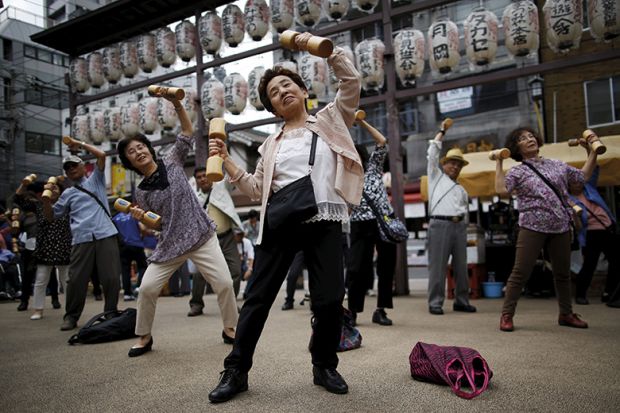Japan and Taiwan’s higher education systems face the dual challenges of an ageing academic workforce and deteriorating working conditions, a major survey warns.
The Changing Academic Profession in Asia survey, completed by nearly 7,000 academics across seven East Asian countries, found that 51.3 per cent of Japanese respondents and 42.7 per cent of Taiwanese participants felt that their working conditions had deteriorated in recent years.
The profile of respondents to the survey, while not fully representative, suggests that the two sectors also face the challenge of an ageing academic workforce, says Futao Huang, a professor in Hiroshima University’s Research Institute for Higher Education.
In Japan, more than one in five (20.5 per cent) respondents to the survey was aged over 60, and a further quarter (25.2 per cent) were in their fifties. Only a quarter (25.1 per cent) were under 40.
In Taiwan, one in five (19.1 per cent) respondents were over 60, a third (33.7 per cent) were in their fifties, and just 11.6 per cent were under 40.
These results are in stark contrast to the responses from several other Asian countries. A significant majority of respondents from Cambodia (67 per cent), Malaysia (66.1 per cent) and Vietnam (70.9 per cent) said that their working conditions had improved in recent years.
In China, meanwhile, more than half of respondents (59.7 per cent) were aged under 40, and fewer than one in 10 (9 per cent) was aged 50 or over.
Professor Huang, in a working paper produced by the UCL Institute of Education’s Centre for Global Higher Education, suggests that the deteriorating working conditions in Japan and Taiwan may reflect the “steady” declines in university budgets in the two countries in recent years.
Commenting on the data, Peter Cave, a senior lecturer in Japanese studies at the University of Manchester, said that the declining youth population in Japan meant that universities were not expanding their student numbers, and therefore their academic staff numbers.
“Because academic staff have permanent positions, most are only replaced when they retire. And because of falling or flat student enrolments, some staff are not replaced at retirement, leading to fewer younger staff,” Dr Cave said.
Professor Huang added that falling enrolments meant that many qualified young academics were unable to find suitable jobs.
“With increased ageing [of the] academic workforce, it would be incredibly difficult for young academics to be employed as full-time academics and for them to be promoted to the upper ladders of professional positions,” he said.
The study does reveal some of the strengths of Taiwan and Japan’s higher education systems: 86.5 per cent of Taiwanese respondents and 81.6 per cent of Japanese participants said that they had doctorates, the highest proportions in the survey apart from Singapore (91.9 per cent). In China, the figure was 41.3 per cent, and it was as low as 9.6 per cent in Cambodia.
But gender balance appears to be a concern in several sectors: in Japan, 15.3 per cent of respondents were women, while in Singapore, 20.5 per cent were women.
Other concerns emerging in the survey include communication between management and academics: about one in three respondents in Japan (33.8 per cent) and Singapore (33 per cent) disagreed that this was good. A “cumbersome” administrative process was a concern for a majority of respondents from China, Taiwan, Japan and Singapore.




